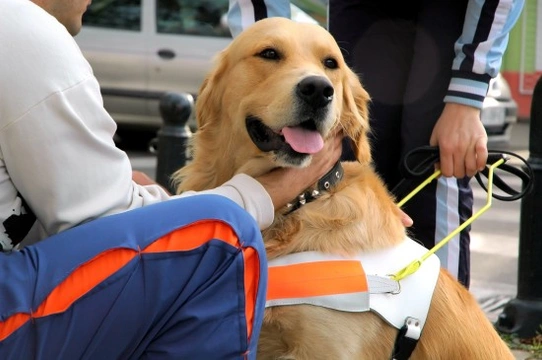
How do working dogs communicate with and alert their handlers of things?
There are a great many different types of working roles that utilise dogs, including things like police and military dogs, assistance dogs for people with disabilities, and herding and guarding dogs. All of these dogs share the traits of high intelligence, receptiveness to training, and a strong bond and understanding of their role alongside of their handler.
Working dogs in various different types of roles are trained in different ways, to perform different tasks and respond to different types of cues. Not only is the communication from the handler to the dog important to this relationship, but how the dog communicates back to the handler and lets them know that the handler needs to know about something is also key.
In this article, we will look at the different ways that different types of working dogs use to communicate with and alert their handlers. Read on to find out more!
Assistance dogs
Assistance dogs help people with disabilities to lead independent lives, such as by serving as the eyes of a blind person or the ears of a deaf person. Assistance dogs are among the smartest around, and only the most intelligent, cooperative puppies and adult dogs make it all the way through the training process to become fully-fledged assistance dogs! These dogs can retain a wide range of different commands, and know how to respond and react to various different cues in different ways.
For instance, an assistance dog for a blind or partially sighted person will constantly communicate with their handler by means of the feedback they give through their harness to the handler’s hands; they will stop if there is a hazard ahead (such as a road) and deliberately walk to navigate their handler around obstacles.
Hearing dogs for deaf people work as an interim translator for aural cues; a hearing dog will be responsible for raising and waking up a deaf person if the fire alarm goes off, for instance, or if the door bell rings. This can take the form or a paw on the arm or a nose against the leg to direct the handler to the source of sound, and allow them to interpret it.
Medical alert dogs
Medical alert dogs are much more commonly kept in America than they are in the UK, but as the role and importance of the work that they do is becoming more and more recognised internationally, so more and more medical alert dogs are being trained up and put to work in the UK. Medical alert dogs are specially trained to use their unique skills to identify the onset or early stages of a potential problem in their handler. This may manifest as detecting the minute scent differences in a person with diabetes whose blood sugar balance is not quite right, or using their advanced senses to detect an impending seizure in someone who is epileptic.
These dogs are taught specific cues to alert their handler of the upcoming problem, and how pronounced or persistent they are in advising their owner that something is amiss will depend on how serious the problem is. The dog will paw at and nose at their handler until the handler gives them a cue to indicate that the message has been received, and their behaviour may become quite pronounced if they feel that their handler is not responding. They are also sometimes trained to bark or look for help, to alert other people if their owner is in distress.
Tracking and scenting dogs
Tracking and scenting dogs are used in a wide variety of different situations, such as by the police for drug detection, searching for missing persons, and even as cadaver dogs to help to find corpses. All of these dogs have a superior scenting ability and pronouncedly superior talent for detecting certain specific smells, and will be matched to a role accordingly.
When the dog in question identifies the scent they have been tasked to find, such as a trail, the presence of drugs or a hidden body, they will bark or whine to indicate the direction or location of the item, and then make a loud, excited fuss once they find it, until their handler approaches and takes over.
Guarding dogs
Guarding and patrol dogs are used to guard and protect property, and serve both as a deterrent to intruders, and as an early alert system for their owners.
Guarding dogs will bark and make a lot of noise when they identify a potential threat, which both tells their owners that there is someone there, and acts to deter a would-be intruder from stepping onto the dog’s patch! Guarding dogs are often left out to roam freely around their property, and will sometimes perform distinct patrols or patterns across the ground as part of their role, keeping a wary eye out for signs of trouble!



